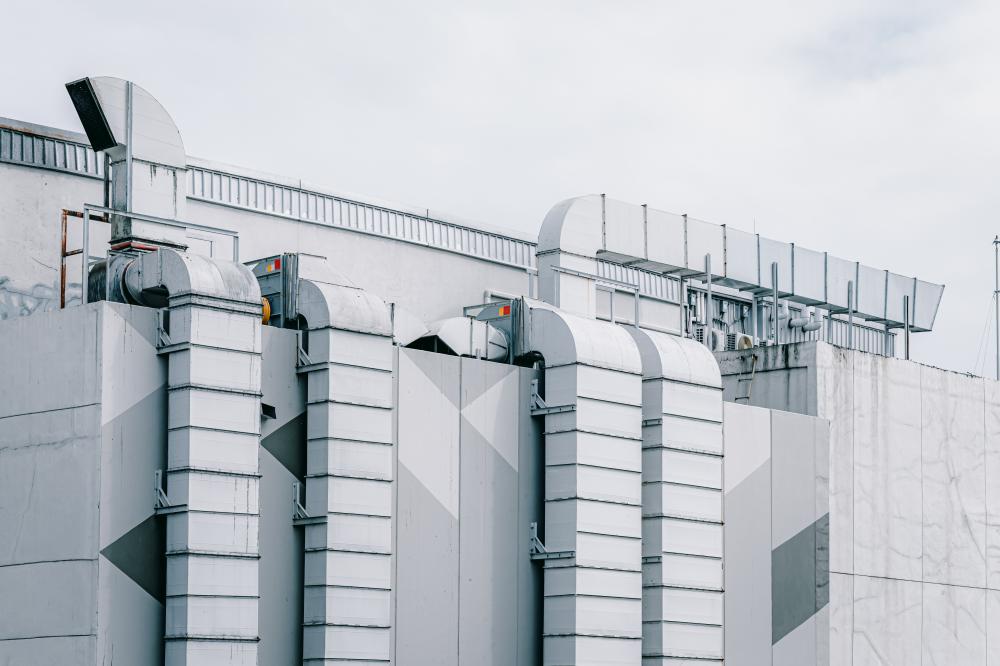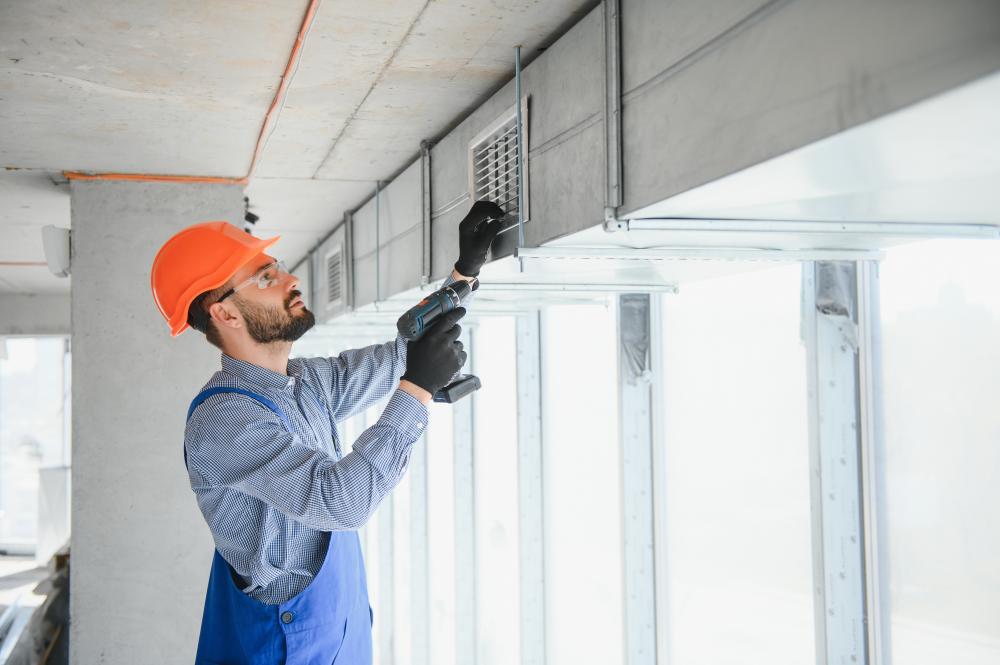
Understanding HVAC Needs
Choosing the Right HVAC System for Large-Scale Buildings involves more than just selecting any off-the-shelf system. It's crucial to understand the specific needs of your building, which vary based on the structure's size, design, and usage. Having served numerous clients in San Fernando Valley, we've seen how each building's unique characteristics dictate its HVAC requirements.
For instance, the seasonal climate variations and energy efficiency standards in California can influence the appropriate system choice. Considering local climate conditions helps optimize system performance, enhancing comfort while minimizing operational costs. A balanced approach ensures that the HVAC system aligns with both environmental factors and operational demands.
Energy efficiency remains a top priority for building owners. We've helped numerous clients navigate through options that not only meet but exceed their energy efficiency goals. By understanding these needs, you can confidently assess the ideal system for your large-scale building.
Evaluating HVAC Options
In our experience, understanding the types of systems available is vital for Choosing the Right HVAC System for Large-Scale Buildings. Central air conditioning systems are often a popular choice for their ability to maintain consistent indoor conditions across expansive spaces. They feature large units capable of cooling multiple rooms simultaneously, making them ideal for office buildings and malls.
Variable refrigerant flow (VRF) systems offer flexibility and efficiency, adjusting cooling needs across different zones. We've installed VRF systems in several hotels and retail spaces, leveraging their capacity to customize indoor climate in specific areas. Their ability to adapt to fluctuating usage patterns can significantly reduce energy consumption.
Chilled water systems, though more complex, provide precise temperature control in large facilities like hospitals and universities. These systems are designed to handle substantial cooling loads, essential for buildings with high occupancy. Our team's expertise ensures these systems operate seamlessly, delivering reliability and efficiency.
Considerations for Installation
When it comes to installing HVAC systems in large buildings, planning is key. We emphasize the importance of a thorough initial assessment. This involves understanding building architecture, insulation quality, and existing ductwork. Such insights guide the installation process, ensuring the system integrates smoothly with the building's infrastructure.
The installation phase also requires attention to zoning. Large buildings often have varied usage patterns, demanding precise zoning to achieve optimal comfort and efficiency. Accurate zoning supports different temperature requirements, assisting in energy-saving efforts.
Importance of Maintenance
After Choosing the Right HVAC System for Large-Scale Buildings, maintenance becomes paramount. An HVAC system's longevity and efficiency rely heavily on consistent upkeep. This includes regular inspections, cleaning, and timely repairs. Our maintenance services focus on preventing breakdowns, extending the system's lifespan while maintaining energy efficiency.
Proactively addressing minor issues can prevent significant problems down the line. This approach also aids in compliance with environmental standards, which is increasingly essential. Our commitment to maintenance ensures that your building remains comfortable year-round, without unexpected interruptions.
Having a routine maintenance schedule adds value to the building by reducing unexpected costs. It keeps the system running at its best capacity, ensuring comfort and reliability, which is a commitment we stand by in San Fernando Valley.
Leveraging Expertise
Choosing the Right HVAC System for Large-Scale Buildings can feel overwhelming, but partnering with seasoned professionals simplifies the process. At San Fernando Valley HVAC, our extensive experience aids in navigating the complex landscape of HVAC options.
Our team works collaboratively with clients, analyzing their needs to recommend tailored solutions. From initial consultation to installation and ongoing support, we provide comprehensive services. We pride ourselves on delivering systems that not only meet technical specifications but also enhance the building's overall environment. Our goal is to ensure each client receives a system that perfectly suits their unique requirements.

Understanding Commercial HVAC Systems
As someone deeply involved in the world of HVAC, I've seen firsthand how Commercial HVAC Systems play a crucial role in ensuring comfortable environments in San Fernando Valley. With our years of experience, we know these systems must be robust to manage large spaces effectively. The key components such as chillers, compressors, and air handlers, work in harmony to maintain desired temperatures. It's fascinating to see how complex yet efficient these systems can be when properly maintained and installed.
Chillers, for example, are pivotal in larger buildings. They circulate refrigerant to absorb and discharge heat, a process essential for cooling. Without this, maintaining a comfortable environment would be challenging. For smaller buildings, rooftop units or RTUs often provide an efficient solution. They are compact, requiring less space, and are easier to manage. Our team has found the adaptability of these units quite beneficial for various clients throughout the Los Angeles area.
Choosing the Right System
When selecting Commercial HVAC Systems, understanding the specific needs of your building is vital. At San Fernando Valley HVAC, we start with an in-depth consultation to assess the unique requirements. Do you need a system that can be easily expanded as your business grows? Or perhaps energy efficiency is your top priority?
Based on these assessments, we often recommend VRF systems for those seeking versatility. These systems offer excellent efficiency and climate control for different zones within a building. They can be a game-changer for businesses focused on reducing their environmental footprint, providing flexibility and control.
For more straightforward applications, split or packaged systems can be appropriate. Our technicians have seen these excel in spaces like small offices or retail stores. Each type of system offers unique benefits, so selecting the right one truly depends on understanding the strengths of each and matching them to your needs.
Maintenance and Efficiency
Maintaining Commercial HVAC Systems is crucial for long-term efficiency. Regular inspections ensure problems are addressed before they become costly repairs. We've always emphasized that a well-maintained system operates more efficiently, saving money and extending the lifespan of the equipment.
Routine maintenance also improves air quality, a vital aspect for any commercial space. Clean systems lead to healthier environments, reducing allergens and bacteria. Our clients in areas like Beverly Hills and Santa Monica appreciate the improved indoor air quality regular maintenance provides. It's rewarding to see the positive impact our services have on their everyday environments.
Innovations and Trends
The HVAC industry is constantly evolving, with new technologies advancing efficiency and comfort. Innovations in Commercial HVAC Systems, such as smart thermostats and automated controls, are transforming how businesses manage climate control. These technologies provide seamless integration and allow for remote monitoring, optimizing energy use.
Our team at San Fernando Valley HVAC is committed to staying ahead of these trends. By adopting new technologies, we ensure our clients benefit from the latest advancements in the industry. Offering cutting-edge solutions is one of the ways we maintain our position as a leading service provider. This proactive approach not only enhances comfort but also aligns with the growing emphasis on sustainability and energy efficiency.
Personalized Service and Support
At San Fernando Valley HVAC, we pride ourselves on providing not just systems, but solutions tailored to each client's needs. We understand that every commercial space is different, which is why our approach is personalized. From installation to ongoing support, our NADCA-certified technicians are there every step of the way.
Operating 24/7, we offer reliable support that clients can depend on. Our service doesn't end after installation; instead, it marks the beginning of a long-term relationship. Whether it's an emergency repair or routine maintenance, our team is dedicated to ensuring your Commercial HVAC Systems are always running optimally. We've built our reputation on trust and quality, ensuring our clients feel secure and satisfied with their HVAC systems.
Importance of Energy Efficiency
Our team at San Fernando Valley HVAC understands the significance of energy-efficient HVAC solutions. Not only do they reduce energy consumption, but they also significantly lower utility bills. This is vital for homeowners committed to sustainable living.
Adopting energy-efficient systems means investing in technology that performs effectively while using less power. This often translates to reduced environmental impact. Our customers appreciate knowing they are contributing positively to the planet.
Moreover, energy-efficient HVAC solutions provide a more consistent and reliable indoor climate. This enhances comfort, which is a priority for anyone who spends considerable time at home.
Understanding these benefits, we consistently educate our clients on the importance of choosing energy-efficient HVAC systems. It's an investment that yields both immediate and long-term returns.
Energy-Efficient Options
When it comes to implementing energy-efficient HVAC solutions, there are numerous options available. We often recommend systems with high Seasonal Energy Efficiency Ratio (SEER) and Energy Star ratings.
Smart thermostats have also become an integral part of these solutions. They allow homeowners to optimize their energy use by scheduling temperature adjustments. This not only saves energy but can also significantly cut costs.
Sealing and insulating ductwork ranks high among our recommendations. This minimizes air leaks, ensuring maximum efficiency of the system installed. A lesser-known option is the use of Aeroseal for duct sealing, which can drastically improve performance.
Maintenance and Longevity
Regular maintenance plays a crucial role in ensuring the longevity and efficiency of HVAC systems. We advise our clients to schedule bi-annual check-ups. These inspections help maintain optimal performance and prevent unexpected breakdowns.
Cleaning or replacing air filters is a simple yet effective step. It enhances airflow and reduces the strain on the system, thus promoting energy-efficient HVAC solutions.
We ensure that our clients are aware of the financial benefits of regular maintenance. A well-maintained system often results in savings that outweigh the costs of the service.
Our team is committed to providing reliable maintenance solutions. This approach helps our customers enjoy consistent comfort while minimizing energy waste.
Unique Design Considerations
Some of our clients have unique architectural features or specific heating and cooling needs. These require tailored energy-efficient HVAC solutions. Our focus is on delivering customized installations that cater to individual requirements.
For instance, the strategic placement of outdoor units can enhance system efficiency. By ensuring that units are not exposed to direct sunlight, we can reduce the workload on the system.
Additionally, the design and layout of ductwork must be carefully considered. Proper sizing and minimal bends minimize resistance, allowing for efficient airflow throughout the property.
Personal Insights and Experiences
From our years of experience, we’ve seen firsthand how energy-efficient HVAC solutions transform homes. Clients often report a noticeable improvement in comfort and air quality.
I vividly recall a client in Simi Valley who upgraded to an energy-efficient system. Not only did they see a dramatic decrease in their utility bills, but the consistent indoor temperature was a welcome change.
Our technicians find joy in educating homeowners. They share tips on how to maximize energy efficiency, contributing to a better living environment for the residents.

Which AC system is most suitable for large buildings?
In my experience, central air conditioning systems are an excellent choice for large buildings due to their ability to maintain consistent indoor temperatures across expansive spaces. They feature powerful units capable of cooling multiple rooms simultaneously, making them ideal for places like office buildings, malls, and conference centers. An example from our work in San Fernando Valley is when we installed a central system in a multi-story office building. The tenants appreciated the uniform climate control, which enhanced comfort and productivity. Another great option is chilled water systems, especially for buildings with substantial cooling loads like hospitals or universities. These systems offer precise temperature control and are highly reliable when properly maintained. If you're weighing options, consider your building's specific needs, including size, design, and typical occupancy levels. Reach out to us for a consultation, and let's find the perfect fit for your space.
Which HVAC system is best for commercial building?
For commercial buildings, it’s vital to choose an HVAC system that can efficiently manage the diverse requirements of the space. We often recommend Variable Refrigerant Flow (VRF) systems to our clients in the San Fernando Valley area. VRF systems provide excellent efficiency and climate control flexibility across different zones within a building, which is critical for spaces with variable occupancy like hotels or retail outlets. Another solid choice could be rooftop units, especially if there's limited indoor mechanical space. They're compact and easier to manage and have been particularly successful in smaller commercial setups like stand-alone retail stores. Each commercial building has unique needs, so it’s crucial to conduct an in-depth assessment. Our experienced team can help determine the best system by analyzing your building's size, usage patterns, and energy efficiency goals. Let's discuss your specific requirements and find a solution that suits your business needs perfectly.
How do you size an HVAC unit for a building?
Sizing an HVAC unit for a building is a critical step that involves more than just measuring square footage. The process typically starts with a comprehensive load calculation, which considers factors like insulation quality, window types, local climate, and occupancy rates. One of our projects involved a high-rise in Beverly Hills, where we took these factors into account to ensure efficiency and comfort. We also factor in the building's heat gain and loss, which can vary significantly based on exterior exposure and internal heat sources. A well-sized system not only optimizes energy use but also enhances equipment longevity. We often engage our clients in this process by explaining how each factor contributes to the overall calculation, ensuring transparency and understanding. If you're considering an HVAC upgrade or installation, let our experts guide you through this process to ensure you get a system that's perfectly matched to your building's needs.
What are the three options to be looked at when choosing a HVAC system?
When choosing an HVAC system, particularly for large-scale buildings, you should consider system type, energy efficiency, and compatibility with building infrastructure. First, determine the system type that best suits your needs—be it a central air system, VRF, or chilled water system—each offering unique benefits and challenges. For example, central systems are great for broad, uniform cooling, but VRFs offer zonal flexibility. Second, energy efficiency is crucial; systems with high SEER (Seasonal Energy Efficiency Ratio) ratings can significantly lower operating costs, a point we always emphasize to our clients in eco-conscious areas like Santa Monica. Lastly, examine how well the system integrates with your building's existing infrastructure, including ductwork and available space. We've seen projects where retrofitting costs can be minimized with the right choice of system. If you're looking to explore these options, our team is here to assist you in navigating through the selections to find the best fit for your building.
How important is maintenance for HVAC systems in large buildings?
Maintenance is absolutely critical for HVAC systems in large buildings. We've seen firsthand how regular upkeep can extend the life of a system and ensure it operates at peak efficiency. For instance, routine inspections can catch minor issues before they turn into major, costly repairs. A large commercial building we serviced in Torrance had significantly reduced downtime and repair costs after implementing a structured maintenance plan we recommended. Regular maintenance also helps in maintaining consistent indoor air quality, which is vital for the health and comfort of the building's occupants. For those who may overlook its importance, consider it an investment; the savings on energy costs can outweigh the expense in maintenance fees. If you're unsure about your current maintenance schedule, we'd be happy to review it and suggest improvements tailored to your building's needs.
How do local climate conditions affect HVAC system choice?
Local climate conditions play a significant role in selecting an HVAC system. For example, here in San Fernando Valley, we deal with substantial temperature fluctuations, which influence system efficiency and operational costs. During a project for a client in the more temperate zone of South San Francisco, we opted for a system that could efficiently manage both heating and cooling, considering their mild winters and warm summers. The local climate can affect your energy consumption patterns and may dictate if your system needs to prioritize heating, cooling, or both. UV exposure, humidity levels, and seasonal weather patterns are all aspects we consider during our consultations. By tailoring our recommendations to local conditions, we ensure an installation that maximizes comfort while minimizing costs. Let's discuss how your home's location might impact your HVAC needs.
How does choosing the right HVAC system impact energy efficiency and costs?
Choosing the right HVAC system has a substantial impact on both energy efficiency and operating costs. We’ve helped numerous clients in areas like Beverly Hills reduce their utility bills by recommending systems that offer high SEER ratings. These systems perform effectively while using less energy, providing consistent climate control without the hefty cost. An energy-efficient system can also have a smaller environmental footprint, aligning with sustainability goals. Beyond energy consumption, the right system reduces wear and tear, lowering maintenance and repair expenses. I remember a client in Simi Valley who was amazed at the returns on their investment after switching to a high-efficiency system. If you're interested in reducing both your carbon footprint and your energy bills, let's talk about the energy-efficient options available for your building.
What are some common misconceptions about commercial HVAC systems?
There are several misconceptions about commercial HVAC systems that we often encounter. One is the belief that bigger is always better; however, an oversized system can lead to increased humidity and energy waste. Another is that maintenance isn't necessary for newer systems, which couldn't be further from the truth. Even the most advanced HVAC systems require regular care to remain efficient. Finally, many assume that once an HVAC system is installed, it doesn't need to be adjusted. In reality, settings like thermostat schedules should adapt to occupancy patterns for optimal performance. Addressing these misconceptions by providing correct information is part of our commitment. If you have any doubts or questions about your commercial HVAC system, we're here to help clarify and assist you in making informed decisions.
